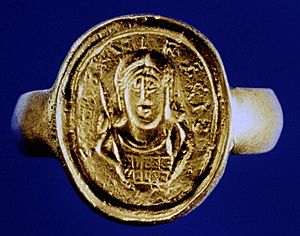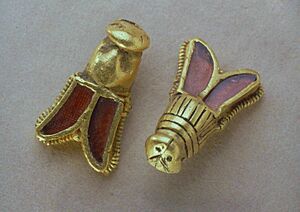Childeric I facts for kids
Quick facts for kids Childeric I |
|
|---|---|

Copy of the signet ring of Childeric (original stolen in 1831). Inscription CHILDIRICI REGIS ("of king Childeric"). The original was found in his tomb at Tournai (Monnaie de Paris).
|
|
| King of the Salian Franks | |
| Reign | c. 457–481 |
| Predecessor | Merovech |
| Successor | Clovis I |
| Died | c. 481 Tournai (present-day Belgium) |
| Burial | Tournai (present-day Belgium) |
| Spouse | Basina of Thuringia |
| Issue |
|
| Dynasty | Merovingian |
| Father | Merovech |
Childeric I was a powerful Frankish leader who lived in the northern part of what was once Roman Gaul (modern-day France). He was part of the Merovingian dynasty, a famous family of Frankish kings. People called him a king, and his special seal ring, found in his tomb, also said "King Childeric." He was the father of Clovis I, who became a very important king and took control of many Frankish kingdoms and a large part of Roman Gaul. Childeric I died around 481 AD.
Childeric's Life and Rule
Most of what we know about the early Merovingian kings comes from a writer named Gregory of Tours, who lived in the 6th century. He wrote a book called History of the Franks.
Childeric's father was Merovech, and the Merovingian dynasty is named after him. Some stories say that Merovech was related to Chlodio, an earlier Frankish king. Chlodio had conquered areas in Gaul, including Tournai and Cambrai. These areas were roughly part of a Roman province called Belgica Secunda, which stretched from north of Paris to the coast. Later, a letter to Childeric's son, Clovis I, suggested that Childeric had been in charge of this region.
Childeric often worked with a Roman general named Aegidius on military actions, especially around the Loire River. At one point, Childeric was sent away to "Thuringia" for eight years because the Franks were unhappy with his behavior. During this time, Gregory of Tours says that Aegidius took on the title of king of the Franks. Some historians believe this story is linked to Roman politics, suggesting that Aegidius might have become a leader when the Roman emperor he supported died.
Childeric likely started his military career working for Flavius Aetius, a Roman general who famously defeated Attila in Gaul. Childeric's military actions often took place far from the Frankish homelands.
In 463, Childeric and Aegidius worked together to successfully push back the Visigoths from Orléans, a city on the Loire River. After Aegidius died, Childeric and a Roman official named Paul defended the Loire region from Saxon raiders. These Saxons were led by a person named "Adovacrius" and were based on islands in the Loire region.
Later, Gregory of Tours also wrote that Childeric worked with "Odovacrius" (who is usually thought to be the King of Italy) against the Allemanni, a group who had entered Italy.
Family and Death
Childeric had several children with his wife, Basina of Thuringia. These included:
- Clovis I (who died in 511 AD).
- Audofleda, who became the Queen of the Ostrogoths by marrying Theodoric the Great.
- Lanthechild.
- Albofleda (who died around 500 AD).
Childeric is believed to have died in 481 or 482 AD. This is based on the fact that his son Clovis died in 511 AD and was said to have ruled for 30 years.
Childeric's Tomb
Childeric's tomb was found in 1653 near a church in Tournai, which is now in Belgium. Many valuable items were discovered inside. These included beautiful gold and garnet jewels, gold coins, a gold bull's head, and a ring with the king's name carved on it. About 300 small golden winged insects, which looked like bees or cicadas, were also found. These had been placed on the king's cloak.
The treasure was first sent to the Habsburg rulers in Vienna, then given as a gift to King Louis XIV of France. He wasn't very impressed and stored it in the royal library. During the French Revolution, this library became the Bibliothèque Nationale de France.
Sadly, on the night of November 5-6, 1831, the treasure of Childeric was stolen. About 80 kilograms of treasure were taken and melted down for the gold. A few pieces were found later in the Seine River, including two of the golden bees. Today, we only know about the treasure from detailed drawings made when it was first discovered and from some copies made for the Habsburgs.
Origin of Napoleonic Bees
When Napoleon was looking for a special symbol for his First French Empire, something that would be even grander than the traditional French symbol (the fleur-de-lys), he chose Childeric's golden bees. He saw them as a symbol of the French Empire. In June 1804, a meeting of the Conseil d'État (a government council) approved the idea of using the bees. The design was created by Vivant Denon, who was the director of the Louvre museum.



